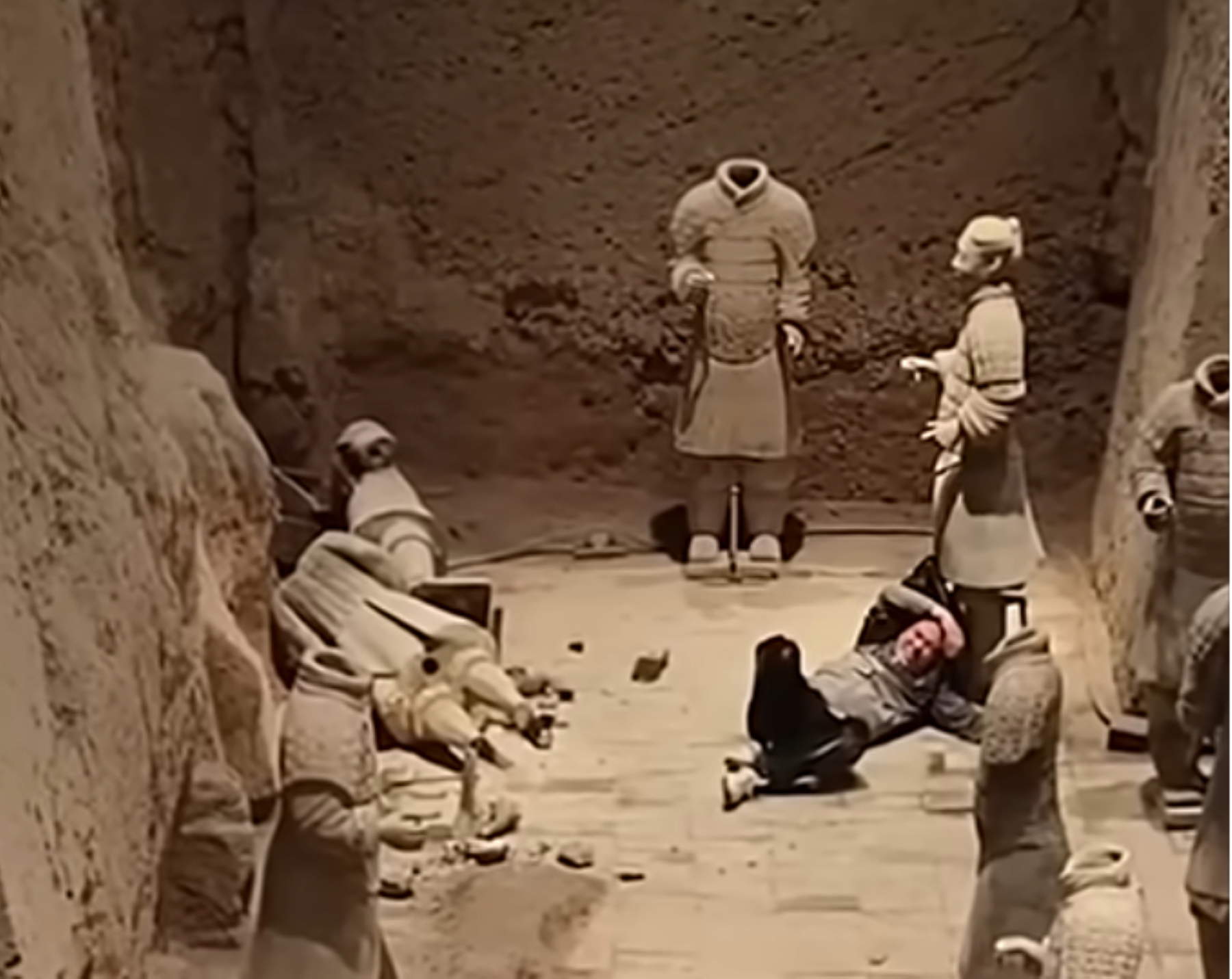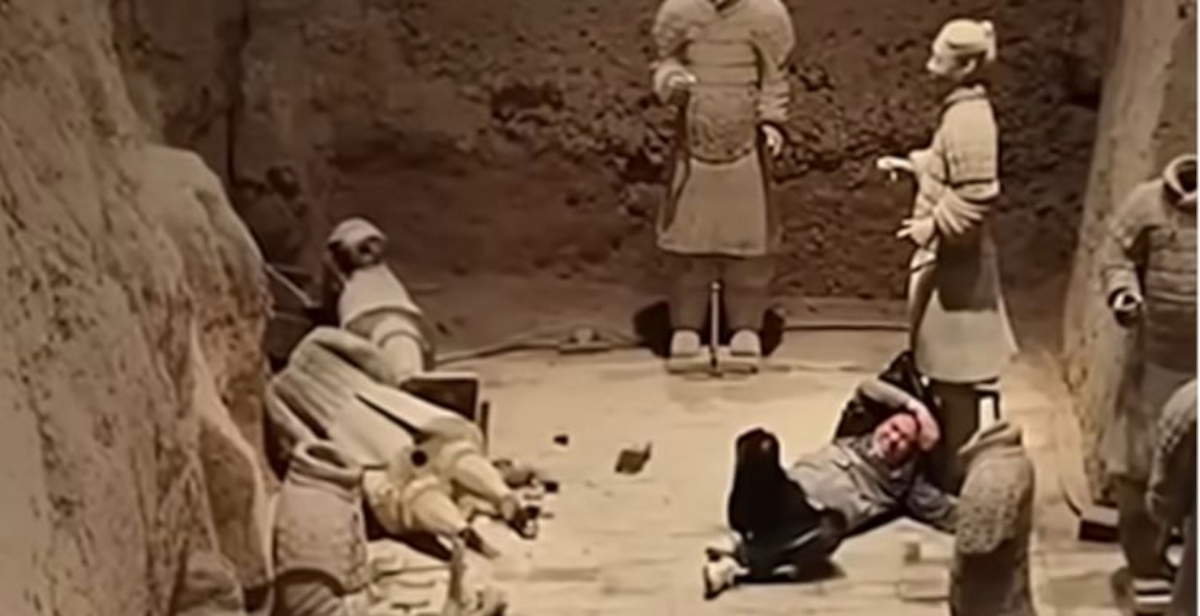On May 30, at the archaeological site in Xi’an, central China, two statues belonging to the ancient Terracotta Army were damaged by a visitor who climbed over the museum’s guards and jumped into Pit No. 3 of the exhibition area, partially destroying the sculptures. The perpetrator, a 30-year-old man identified by authorities only by his last name Sun, was apprehended by local police and is now in custody. According to reconstructions by the Xi’an Public Security Bureau and reports in Chinese media, the incident occurred around 5:30 p.m. Friday. The man, who was on a visit to the museum, allegedly suddenly stepped over fences and protective nets and then threw himself inside the pit, which is more than five meters deep. As a result of the impact, at least two of the statues present were significantly damaged. The 30-year-old man is reportedly suffering from mental disorders, according to local sources. Images of the scene, captured by surveillance cameras and later released online, show an individual lying on the floor next to one of the toppled statues, with numerous fragments scattered all around.
The dynamics were confirmed by authorities: the visitor, after breaking into Pit No. 3, allegedly pushed and pulled some of the sculptures, causing varying degrees of damage to the artifacts. Law enforcement intervention was immediate. The man was detained on the spot and taken away by officers, while museum staff proceeded to isolate the affected area. The two affected statues, considered part of the Terracotta Army dating back more than 2,000 years, will now undergo restoration. The damage was judged to be severe but potentially reversible. The Terracotta Warriors, in fact, constitute one of the most important and impressive funerary complexes in the history of world archaeology. Located in Lintong, near Xi’an in Shaanxi Province, the Warriors ideally guard the mausoleum of China’s first emperor, Qin Shi Huang (Handan, 259 B.C.- Shaqiu, 210 B.C.). The action taken by the man is therefore likely to have very serious consequences: according to Chinese law, willfully damaging cultural property constitutes a severely punishable offense, with prison sentences of up to ten years. In addition to the criminal conviction, the perpetrator could be forced to cover the often very high costs of restoration: in such cases, there is even talk of tens or hundreds of millions of yuan. In the meantime, authorities have already started appraisals to quantify the damage and plan recovery efforts.

The mausoleum, which covers about 49 square kilometers, was commissioned by Qin Shi Huang himself in the 3rd century B.C., during his reign (221-210 B.C.), with the intention of being guarded in the afterlife by a loyal and silent army. The first evidence of the Terracotta Army came to light on March 29, 1974, when a local farmer, Yang Zhifa, accidentally discovered some fragments during agricultural work. Since then, three different burial pits have been excavated and have yielded more than 2,000 warriors and horses. However, archaeologists estimate that at least another 6,000 specimens are still buried underground. Each statue, carved in life-size terracotta, has unique features, confirming the level of detail and individualization achieved by the artisans of the time. In 1987 the archaeological site was officially recognized byUNESCO as a World Heritage Site. The body emphasized its extraordinary cultural significance, describing the tomb of the first emperor as “the largest in Chinese history, with a unique standard and arrangement and a large number of fine funerary objects.” The complex bears witness to the founding of the first unified empire, the Qin Dynasty, which exercised unprecedented authority in the third century B.C. in the political, military and economic spheres, contributing decisively to the progress of Chinese civilization. The Terracotta Army is still considered one of the most emblematic symbols of China’s ancient artistic and military sophistication. The statues represent warriors, officers, archers and horses, organized according to a strict tactical arrangement.
The incident thus rekindles attention to the issue of protecting archaeological sites and the need to ensure adequate security measures, especially in places frequented by thousands of tourists each year. The fence breached by the 30-year-old was intended precisely to prevent direct access to the statues. Despite the presence of protective cordons and nets, the man’s impulsive act demonstrated how such barriers can be overcome in a matter of seconds. Museum authorities have not released further details on the exact extent of the damage or the expected time frame for the restoration of the two statues. Regardless, the incident has been widely reported in the international media, fueling a debate about the fragilities of the world’s cultural heritage and the risks associated with episodes of an unpredictable nature. The Xi’an site continues to be a landmark in ancient Chinese history and remains open to the public, albeit with new security measures being evaluated. The priority now remains to safeguard the integrity of the artifacts and ensure that such incidents cannot happen again.
 |
| China, tourist throws himself on Xi'an Terracotta Army warriors and damages two of them |
Warning: the translation into English of the original Italian article was created using automatic tools. We undertake to review all articles, but we do not guarantee the total absence of inaccuracies in the translation due to the program. You can find the original by clicking on the ITA button. If you find any mistake,please contact us.